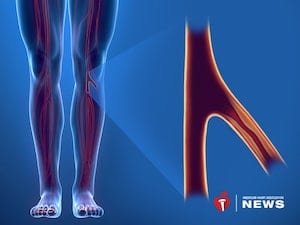
THURSDAY, Aug. 9, 2018 (American Heart Association) — People with obesity are known to be at increased risk for coronary heart disease, the most common type of heart disease. Now, a new study shows obesity may also increase the chance of developing peripheral artery disease.
Coronary artery disease develops when the arteries that supply blood to the heart become stiff and narrow. Peripheral artery disease affects the arteries that supply blood to the arms, legs or feet and often leads to pain or cramping in the legs or hips while walking or climbing stairs.
At least 6.8 million Americans ages 40 and older have peripheral artery disease. If left untreated, peripheral artery disease can advance to critical limb ischemia, a severe blockage in the arteries that, in some cases, can only be treated by having the affected limb amputated.
Experts say previous studies have found that smoking, diabetes and high cholesterol increase a person’s risk of developing peripheral artery disease, but the role that obesity plays in the disease has been unclear.
For the new study, published Aug. 9 in the Journal of the American Heart Association, researchers at Johns Hopkins University School of Medicine in Baltimore analyzed data on nearly 14,000 black and white men and women enrolled in the ongoing Atherosclerosis Risk in Communities Study, which began in 1987. They found that people who were obese were 1.5 times more likely to develop peripheral artery disease with critical limb ischemia than those who were normal weight.
“With increasing obesity, you have an increased risk of [both diseases], which means an increased risk of limb loss,” said Dr. Caitlin Hicks, the study’s lead author. “Everybody knows about diabetes and hypertension and their relationship to obesity, but now we’re connecting the risk of lower extremity issues to obesity.”
Hicks said their findings show why it is important for doctors to advise patients with peripheral artery disease who are obese to lose weight. But she admitted that losing weight can be particularly hard to accomplish for those with the condition.
“It’s a vicious cycle, because as people get obese [and develop peripheral artery disease], they have trouble walking … which makes it harder to lose weight, because they’re not active,” said Hicks, an assistant professor of vascular surgery and endovascular therapy at Johns Hopkins University School of Medicine.
Dr. Aruna Pradhan, a cardiologist at Harvard Medical School in Boston who was not involved in the study, noted that the study researchers couldn’t account for people whose weight may have fluctuated. She also noted that it was possible that obesity-related conditions such as diabetes might be driving the higher rates of peripheral artery disease and critical limb ischemia, rather than obesity itself.
“But that doesn’t detract from the message that reducing weight could very certainly impact the risk of peripheral artery disease, as it does with other cardiovascular diseases,” said Pradhan, who is chair of the American Heart Association’s Peripheral Vascular Disease Council.
Pradhan said she sees many patients with advanced peripheral artery disease who are awaiting surgery to have a limb amputated.
“They’re devastated by the dread of losing a limb and filled with regret over what they could have done to prevent it,” she said. “Peripheral artery disease is an epidemic among populations we’re paying less attention to: African-Americans, veterans, people without health care. We need to put it front and center. We need to pay more attention to this disease.”
